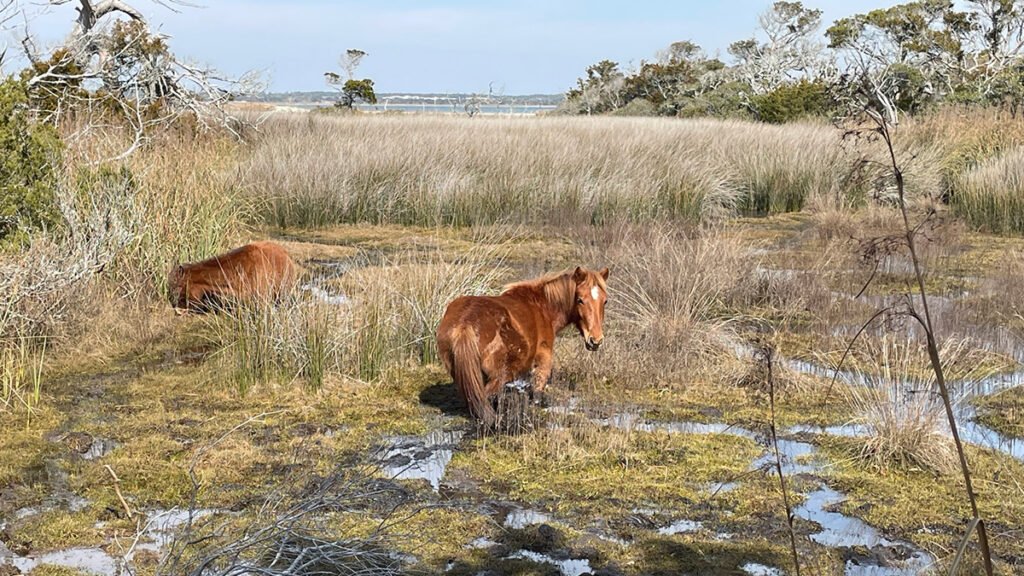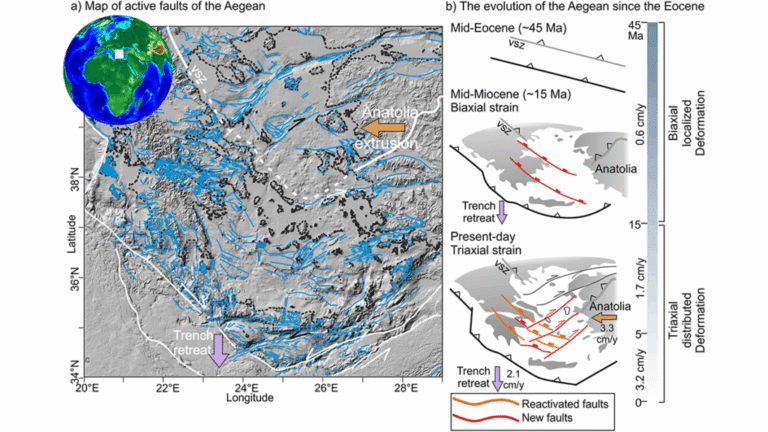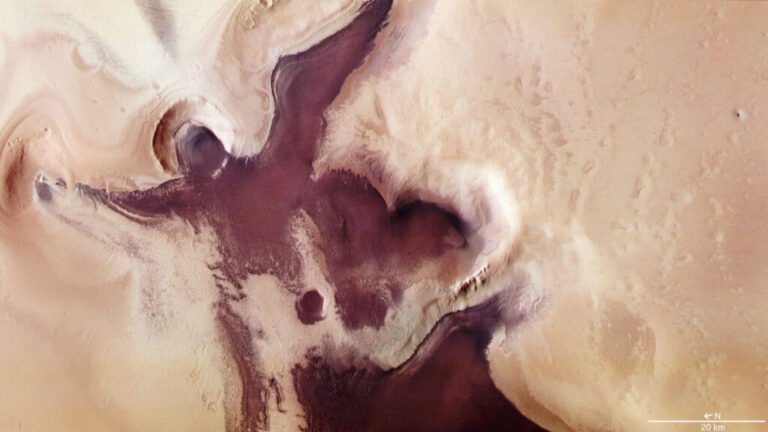


Shackleford Banks is an 8-mile-long barrier island off the coast of North Carolina made up of sandy beaches, marshes, and maritime forests. There are no vacation rentals, boardwalks, or seafood restaurants serving the residents of Shackleford Banks. That’s because the residents are more than 100 wild horses that call the sandy dunes of this island home.
The delicate ecosystem of Shackleford Banks is facing the effects of a changing climate, such as increasingly volatile storms and flooding, drought, erosion, and saltwater intrusion. The island’s low elevation means its freshwater sources can be infiltrated with salt water during king tide events and storm surges. During stretches of drought, freshwater sources for the island’s equine residents can run dry, leaving the horses to compete for these vital resources.
“These horses have been out here long enough to adapt and survive, but freshwater availability is a critical resource,” said Matthew Sirianni, a geoscientist at East Carolina University who will present his research on 16 December at AGU’s Annual Meeting. Sirianni and colleagues monitored freshwater sources on Shackleford Banks, finding that horse behavior changed when freshwater sources were scarce. As saltwater intrusion and coastal hazards increase along the islands off the coast of North Carolina known as the Outer Banks, these findings can improve understanding of how to manage wildlife during a changing climate.
Foraging for Fresh Water
Wild horses have lived on Shackleford Banks for centuries. One theory suggests they arrived in the 1500s, swimming to shore after Spanish explorers were shipwrecked along the East Coast. Genetic testing suggests today’s Shackleford Banks horses are related to Spanish horse breeds, but early English settlers also brought horses with them that may also have escaped or been abandoned along the Outer Banks.

Today, Shackleford Banks’s wild horse population must be kept to a manageable number so that the island and its resources aren’t overwhelmed. National Park Service workers dart the mares with hormonal birth control each year to keep herd size low. The small, hardy equines have adapted to a life of eating marsh grass, sea oats, and wax myrtle. They drink from ponds and freshwater seeps, and they also dig holes in the sand to reach the freshwater belowground when other sources have dried up.
In the new study, researchers monitored surface and groundwater levels and conductivity—a proxy measurement for salinity because higher conductivity values mean saltier water—in six water sources (two ponds, one groundwater seep, and three dig sites) located across the island.
“Barrier islands often develop a freshwater lens in the subsurface that floats on top of the denser, saltier water,” Sirianni said. “By monitoring water level and water conductivity, we can, over time, see whether the freshwater lens is shrinking, growing, or getting saltier, which tells us how the island’s water resources are responding to things like tides, storms, or droughts.”
Researchers installed motion-activated trail cameras near the water sources to capture still shots of animals drinking. They then grouped time-stamped photos to connect the horses’ drinking activities with water level and conductivity data. From there, they searched for water usage patterns, as well as for information about how long horse-dug holes (some as deep as 3 feet) stayed full of fresh water.
“Preliminary results from July 2024 to April 2025 indicate that horses spend more time drinking at dig sites, where conductivity is lower and more stable, compared to ponds and the groundwater seep, where conductivity is higher and more variable. However, when rainfall is low, dig sites often run dry, leading horses to drink from these higher-conductivity sources,” Sirianni said.
A Saltier Future?
“In the past, we’ve said that horses wouldn’t drink brackish water, but we were wrong. They do drink brackish water when that’s the only thing available to them.”
“With the research that [Sirianni] is doing, we have learned that these ponds can be really brackish,” said Linda Kuhn, a volunteer veterinarian with the National Park Service who was not involved with the research. “In the past, we’ve said that horses wouldn’t drink brackish water, but we were wrong. They do drink brackish water when that’s the only thing available to them.”
If the freshwater sources become saltier, history has already shown how the wild horses could be in trouble. On the island of Chincoteague, Virginia, equine deaths and illness were linked to a toxic increase in salinity in freshwater supplies, possibly wrought by the storm surge from Hurricane Erin.
It took 2 weeks for volunteers and observers to figure out what was wrong at Chincoteague. “Here we have [Sirianni] giving us data in real time. He also has cameras out there so he can see who’s drinking.” In light of what happened to the Chincoteague ponies after Hurricane Erin, “it’s just such an important study at this time,” Kuhn said.
“These horses have been here for many years and weathered many storms, so…they are a symbol of wildness and freedom even in the face of adversity.”
And with the potential for stronger, damaging storms in the future, the wild horses in this precarious island habitat may face more water and food shortages—along with danger from the land itself. Previous modeling studies suggest sea level rise will cause the already shallow groundwater table to reach the surface, as well as cause the shoreline to retreat as land subsidence and erosion worsen.
Sirianni plans to continue monitoring Shackleford Banks’s wild horses and water sources through at least July 2026 while he works on a final study manuscript about his findings. But he hopes to fund this research into the future. “These horses have been here for many years and weathered many storms, so I like that they are a symbol of wildness and freedom even in the face of adversity,” he said.
—Rebecca Owen (@beccapox.bsky.social), Science Writer
Citation: Owen, R. (2025), What salty water means for wild horses, Eos, 105, https://doi.org/10.1029/2025EO250433. Published on 21 November 2025.
Text © 2025. The authors. CC BY-NC-ND 3.0
Except where otherwise noted, images are subject to copyright. Any reuse without express permission from the copyright owner is prohibited.


